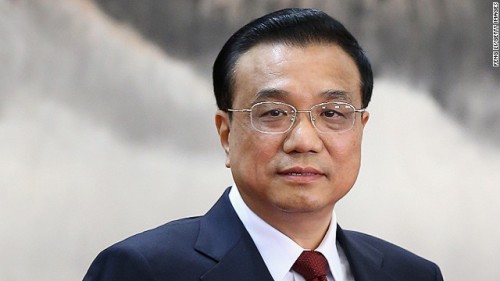China formally committed to halting the rise in its greenhouse gas emissions within the next 15 years on Tuesday (June 30, 2015), in a much anticipated strategy to help build a U.N. climate deal in 2015.

The world’s top greenhouse gas emitter said it would invest more in clean energy and plant more carbon-absorbing forests as part of the plan.
The Chinese plan chimes with targets announced in November, when Beijing reached a key climate change deal with Washington to cap its emissions by 2030.
“China’s carbon dioxide emission will peak by around 2030 and China will work hard to achieve the target at an even earlier date,” Chinese Premier Li Keqiang said in a statement after meeting French President Francois Hollande in Paris.
French Foreign Minister Laurent Fabius called China’s plan an “excellent sign” for the United Nations summit in Paris from Nov. 30 to Dec. 11, which intends to agree a global deal to combat climate change after past failures.
China did not, however, say at what level its emissions would peak. The cap is the first set by Beijing, which had argued that it needed to burn more fossil fuels to end poverty and that developed nations must lead in climate action.
In a new element beyond the U.S.-China deal, Beijing said it would cut its CO2 emissions per unit of gross domestic product by 60-65 percent from 2005 levels by 2030. That would deepen a 40-45 percent cut already set by Beijing for 2020.
The world’s second-largest economy also aims to increase the share of non-fossil fuels in its primary energy consumption to about 20 percent by 2030, the statement said, as part of a strategy to limit more heatwaves, floods and rising sea levels.
Carbon Price Up
Benchmark EU carbon prices rose after the news and were last 1.4 percent higher at 7.47 euros a tonne.
China accounts for a quarter of world greenhouse gases and its plan, submitted to the United Nations on Tuesday, means governments accounting for more than half the global total have now outlined goals for climate action beyond 2020.
About 40 countries emitting just over 30 percent of world emissions have previously submitted their plans, including the United States and the European Union. National plans will be the building blocks of a Paris accord.
Separately, the United States and Brazil pledged to increase their share of renewable energy in electricity generation.
South Korea said it would cut greenhouse gas emissions by 37 percent below business-as-usual levels, deeper than its earlier intention.
“The United States and China can no longer use inaction by the other as an excuse for ignoring the risks we all face from climate change. Both countries are acting,” said Bob Perciasepe, president of the U.S. Centre for Climate and Energy Solutions think-tank.
Many experts outside China reckon it can peak its emissions before 2030, given signs such as a fall in coal consumption in 2014. Beijing is under strong pressure to shift to renewable energies, partly to curb air pollution.
“”In our estimates the peak would be around 2025 or even earlier,” Hanna Fekete of the independent New Climate Institute think tank in Germany, which tracks pledges, told Reuters.
She said she did not think Beijing’s plan would affect the group’s estimates last year that global temperatures are set to rise by 3.1 degrees Celsius (5.6 Fahrenheit) by 2100, far above a U.N. ceiling of 2 degrees (3.6F).
Li Shuo, climate analyst Greenpeace China, said: “China has only ever been on defence when it comes to climate change, but today’s announcement is the first step for a more active role. For success in Paris, however, all players – including China and the EU – need to up their game. Today’s pledge must be seen as only the starting point for much more ambitious action. It does not fully reflect the significant energy transition that is already taking place in China. Given the dramatic fall in coal consumption, robust renewable energy uptake, and the urgent need to address air pollution, we believe the country can go well beyond what it has proposed today.”
Samantha Smith, Global Climate and Energy Initiative leader, WWF, stated: “This is the first major developing country emitter to set a total emissions peak target. In doing so, China has committed to both global climate security and to a transformational energy transition at home. We emphasise the importance of the fact that China has made commitments beyond its responsibility as a developing country. But we hope that China will continue to find ways to reduce its emissions, which will in turn drive global markets for renewable energy and energy efficiency.”
Bi Xinxin, coordinator CAN China, emphasised: “It is clear that the Intended Nationally Determined Contribution (INDC) which was lodged by China today is a serious step forward for the country’s transformation to low carbon and climate resilient development. Already a world leader in renewable energy, the government has announced it will roll out as much low carbon energy as the entire US electricity system by 2030. While the plan is indeed a strong effort, it should be viewed as the floor upon which additional efforts will be built. There are early indications that the country could exceed the targets it has set for itself. Bold actions are required from all levels of governments as well as from the indispensable private sector and civil society. China’s commitment towards the Paris agreement is an important milestone on the way to Paris and can catalyse stronger action from the rest of the world.”
By Julien Ponthus (Reuters)
